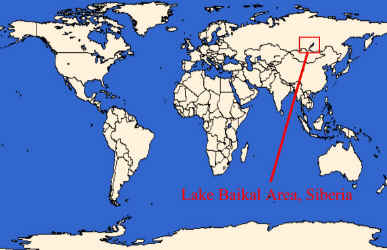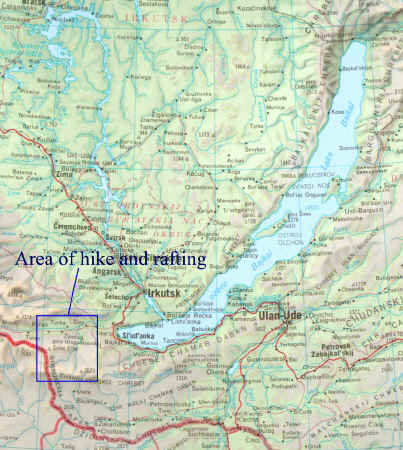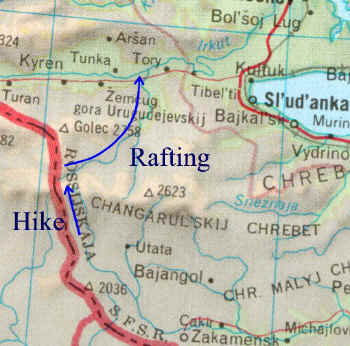Description
The following is a description of the 14 days of hiking and rafting. It is an adaptation of the program as it was sent to me beforehand (thanks, Lena). On a trip like this you can never plan each day exactly, since much depends on the weather, possible mishaps with the rafts, the water level and so forth.
Hiking/rafting the Zun-Murin, Siberia, August 2001
or: Lewis and Clarke, eat you heart out…
Approximate are of the hike and rafting itinerary:



Hiking Part Length — approximately 60 km
Rafting Length — 150 km, about 120 obstacles
Day 1 (July 28). Arrival at Irkutsk on the plane from Moscow, at around 6 am.. The bus met the group at Irkutsk and (after loading all the equipment) started going South. On the way we passed Sludyanka, on the westernmost point of Lake Baikal, where we had lunch from freshly caught Baikal fish. Transfer to the district center of Kyren, situated in the center of the Tunkin Hollow. Visit to Hangar-Ulla resort. The resort (formerly only accessible to high Party officials) is founded near the mineral springs, long used by local inhabitants for sanitation and treatment of various diseases. It is interesting to mention that the two springs bring up water which is different in its composition and healing properties, though only two dozen meters separate them.. We were supposed to stay overnight at the National Park hotel or at private family inns (B&Bs), but since the village was flooded (!) we couldn’t go there. Instead we camped in the backyard of a local farmer – the same man who was arranging the horses for carrying the equipment on the hike. We had dinner in his house, a typical Siberian farmer’s house: no running water, no plumbing, no indoor toilet, but electricity and telephone were available.
Day 2 (July 29). Trekking up to the Valley of the Kharagun River. We had 15 people (14 Russians and me) with their own luggage, plus all the rafting gear. We rented four horses to carry the equipment – they were guided by four horsemen (on horseback themselves). Because the horses could carry enough luggage, about five of us didn’t have to carry a backpack, but the rest of us did. Going uphill the character of the vegetation changes, huge poplars give way to conifers typical of the mountain taiga. During halts impatient fishermen tried their luck and went fishing – there is much fish (grayling) in the Kharagun River (supposedly anyway – we didn’t catch anything until the fourth day). The path winds it way along the river (too small to raft at this point), crossing it many times: we had to wade through numerous times. Of course I had the misfortune of falling flat in the water right the first crossing…
Day 3 (July 30). Trekking along the valley of the Kharagun River to its tributary the Khamyr Brook and climbing along its steep serpentine to Korovic (Cow) Lake – a small mirror of dark water set in a frame of cedars. That night was the last camp before the mountain pass at the height of 2300m.
Day 4 (July 31). Mountain pass 2300m. This area that is devoid of forests, much like high alpine meadows. From there a long descent to the river Bolshoy Uguday, which is the Zun-Murin tributary. In one of the places the path crosses a dense thicket of ”pink radiola” more known as “golden root”. We also passed an ancient volcano crater and numerous stone scatterings. From the place where the brook runs into the Bolshoy Uguday River one can see a snow hill, which is quite unexpected so far from the mountain pass. This phenomenon – the absence of snow in the upper part of the pass and massive snow hills in the middle and lower flow of rivers and brooks is characteristic of this area. Camping on the left bank of the river – the end of the hike (if the water level had been lower we would have had to walk another day, but since there was enough water we judged we could start rafting here).
Day 5 (August 1). Assembling the catamarans, building a banya. The Russians call their rafts catamarans (or more frequently catarafts): when you have a look at the pictures you will understand why. A banya is a Russian steam bath, which we built on the bank of the river. See the pictures to get an idea of how this works.
Day 6 (August 2). Finish assembling the catamarans, start the rafting.
Day 7 (August 3). Spent the morning repairing one of the rafts, which had a problem. Rafted the rest of the day.
Day 8 (August 4). Rafted during the morning. Shortly after lunch, one of the rafts ruptured on a sharp stone in the river (at this point the river was still very shallow and we actually had to get off many times to push the rafts when they got stuck). Spent the rest of the day repairing the rupture; by the time we were finished it was too late to proceed any further.
Day 9 (August 5). Rafting. Around mid-day we finally reached the point where the Bolshoy Uguday flows into the Zun-Murin. Now we started to go through many interesting rapids. Fishing (greyling, taimen (salmon trout) and lenok).
Day 10 (August 6). Rafting. Camping just before the “Shurik Rapids” (category 5), the most complex rapid on our route.
Day 11 (August 7). Free day. Built another banya. Caught a lot of fish.
Day 12 (August 8). Rafting. Decided to walk around the Shurik rapids, since we deemed they were too dangerous to go through.
Day 13 (August 9). Half a free day, which we used to shoot a movie (really!). See the pictures for details. Rafting for a half day. Last night in the woods.
Day 14 (August 10). Rafting to the settlement of Zun-Murin in the Tunkin Hollow. Catamaran disassembling. The same bus picked us up and drove us to Irkutsk where we checked into the hotel (Shower! Warm water! Soap! Shampoo!) and had a nice goodbye dinner (Wine! Wodka! Meat!).
Day 15 (August 11). Transfer to the airport for the flight back to Moscow (and New York for the lone foreigner on the trip, i.e. me).